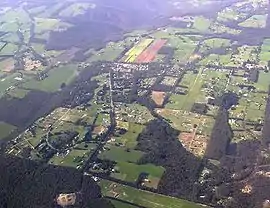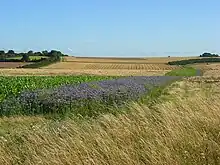
Working landscapes are landscapes used for farming, ranching and/or forestry.[1] Recently, these have become the focus of efforts to conserve biodiversity,[2] as these now cover more than 80% of Earth's land,[3] and therefore offer increasing opportunities for conservation and restoration. Though some parts of these landscapes may be used so intensively that they may be unable to sustain native species, working landscapes generally also include significant areas of habitats suitable for native species within their diverse and multifunctional mosaics of intensively used, fallow, and regenerating areas.
Working landscapes are critical to sustain biodiversity

Conventional protected areas can offer high quality habitats with strong protections for native species, but their total global extent will always be limited. As landscapes without human inhabitation and use are already rare and only getting rarer, conservation in working landscapes has become increasingly critical to the future of biodiversity.[1] For example, the conservation of 20% of working landscape area for native habitats has been proposed as a global conservation target,[2] and is only one among many strategies for conservation beyond protected areas that falls under the rubric of Other effective area-based conservation measures. Satellite mapping has been increasingly deployed to monitor how human activities modify working landscapes over time across extensive regions. [4]
See also
References
- 1 2 Kremen, C.; Merenlender, A. M. (2018-10-19). "Landscapes that work for biodiversity and people". Science. 362 (6412): eaau6020. doi:10.1126/science.aau6020. ISSN 0036-8075. PMID 30337381. S2CID 53012788.
- 1 2 Garibaldi, Lucas A.; Oddi, Facundo J.; Miguez, Fernando E.; Bartomeus, Ignasi; Orr, Michael C.; Jobbágy, Esteban G.; Kremen, Claire; Schulte, Lisa A.; Hughes, Alice C.; Bagnato, Camilo; Abramson, Guillermo; Bridgewater, Peter; Carella, Dulce Gomez; Díaz, Sandra; Dicks, Lynn V. (March 2021). "Working landscapes need at least 20% native habitat". Conservation Letters. 14 (2). doi:10.1111/conl.12773. hdl:11603/20123. ISSN 1755-263X. S2CID 226331859.
- ↑ Ellis, Erle C.; Gauthier, Nicolas; Klein Goldewijk, Kees; Bliege Bird, Rebecca; Boivin, Nicole; Díaz, Sandra; Fuller, Dorian Q.; Gill, Jacquelyn L.; Kaplan, Jed O.; Kingston, Naomi; Locke, Harvey; McMichael, Crystal N. H.; Ranco, Darren; Rick, Torben C.; Shaw, M. Rebecca (2021-04-27). "People have shaped most of terrestrial nature for at least 12,000 years". Proceedings of the National Academy of Sciences. 118 (17): e2023483118. Bibcode:2021PNAS..11823483E. doi:10.1073/pnas.2023483118. ISSN 0027-8424. PMC 8092386. PMID 33875599.
- ↑ Hu, Tongxi; Toman, Elizabeth; Chen, Gang; Shao, Gang; Zhou, Yuyu (2021). "Mapping fine-scale human disturbances in a working landscape with Landsat time series on Google Earth Engine" (PDF). ISPRS Journal of Photogrammetry and Remote Sensing. 176: 250-261. doi:10.1016/j.isprsjprs.2021.04.008.